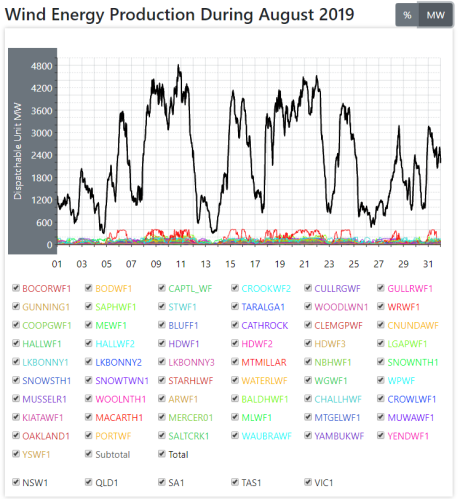New York State’s Efforts to Run on Wind Power Have Proved to Be a Dismal Failure
by Rudy P. SysAdmin at howtofindthemoneyJust like everywhere else, New York State’s efforts to run on wind power have proved to be a dismal failure. Here’s the news: calm weather is a thing, always and everywhere.
Whether it’s the fertile fields of northern Germany, the rolling hills of northern South Australia or farmland surrounding the great Lakes of North America, the proportion of time when wind turbines are producing nothing is always greater than the periods when these things are producing anything worth mentioning, at all.
Across the Eastern Grid the annual average capacity factor for wind power generation is around 28%, and that’s with wind farms located in 5 States.
Currently there’s 6,702 MW of total capacity situated in Tasmania, South Australia, Victoria, NSW and Queensland and spread from Hornsdale in the Mid-North, west to Cathedral Rocks on lower Eyre Peninsula and south to Millicent in the South-East of South Australia; down to Cape Portland (Musselroe) and Woolnorth (Cape Grim) in Tasmania; all over Victoria; at Broken Hill in the far west of NSW, and right up to Glen Innes in the New England Ranges of NSW and at Mount Emerald on the Atherton Tablelands in Queensland.

And even with that huge geographical spread, there are numerous occasions when their combined output amounts to a risible fraction of their total notional capacity (see above).
So the utterly dismal results from New York State should come as no surprise.
Wind: A bad buy for the energy-hungry
New York state’s installed wind capacity is currently 1987 megawatts from 28 projects throughout the state. This is almost equal to the 2,080 MW of capacity at the Indian Point Nuclear facility, which operates at 95 to 98 percent of capacity, providing clean, zero-emission and, most importantly, dependable electricity. Indian Point can therefore be relied upon for an average of 2,000 MW of electricity. You might think with almost 2,000 MW of wind capacity, the contribution to the state’s electrical supply must be significant. Unfortunately, that is not the case, especially during the summer months.
During the summer, residential consumers, commercial and industrial facilities consume much more electricity than other times of the year, typically for air conditioning and energy-intensive uses during these months. Demand for electricity during the summer months can be as much as twice the demand during the spring and fall.
So, how did New York state’s wind turbines do during the past summer?
There were 94 days during the summer season. On 41 of those days, the 1,987 MW of installed wind capacity generated a daily average of less than 200 MW. There were only 17 days during which the average daily output exceeded 500 MW, or 25 percent of installed capacity, and only three days that output exceeded 40 percent of installed capacity.
Even more troubling was the output during a typical summer day. While demand for electricity peaked from noon until 6 p.m., output from the wind turbines was generally highest at night, dropping during those hot, humid, still afternoons, often to the point of actually producing zero megawatts of electricity.
On average, the 1,987 MW of wind capacity delivered 306 MW throughout the summer, or 15.4 percent of installed capacity.
You might argue that this analysis shows a need for additional wind factories. Do the math. If we wish to replace the Indian Point nuclear facility with wind power, we need to generate an additional 2,000 megawatts of power. An installed wind capacity of almost 13,000 MW is required. With wind factories typically rated at 100 to 200 MW, that’s 65 to 130 additional wind factories required. To generate an additional 5,000 MW would require 32,500 MW of installed capacity, or 162 to 325 new wind factories. But still, we would not be able to rely on them during those hot and humid summer afternoons.
At the same time, the New York State Energy Research and Development Authority is granting hundreds of millions of dollars to developers to install each new wind facility. One recent grant has provided $198 million to a developer of a 100 MW (installed capacity) facility. In addition, these developers receive incentives in the form of production tax credits or investment credits given by the state and federal government for every megawatt the turbines actually are capable of producing.
That money doesn’t really come from the state and federal governments — that’s tax money from every New York State resident.
The 10 largest coal producers and exporters in Indonesia:
Source: Stop These Things
Sponsor Ads
Created on Oct 22nd 2019 20:54. Viewed 601 times.
Comments
No comment, be the first to comment.



